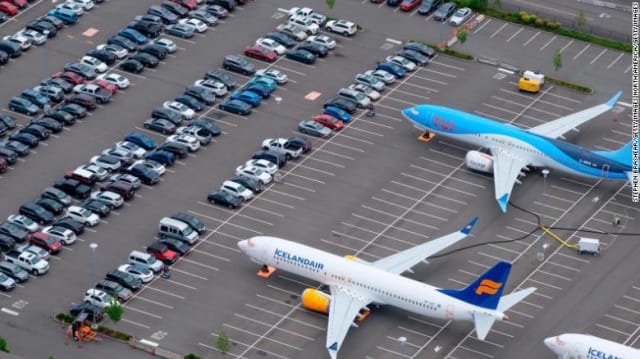News, Ideas, Tips, Great Fixes ......
737 MAX Certification Could Open Big Rifts in Global Aviation Market
From engineering.com

By Matthew Greenwood
The European air safety regulator could break with the Federal Aviation Administration (FAA) on certifying the Boeing 737 MAX for flight again—which could cause significant turmoil in the global aviation sector.
The European Union Aviation Safety Agency (EASA) is insisting on conducting its own flight tests of the aircraft before allowing it to fly again in Europe—rather than just relying on FAA certification.
“EASA intends to conduct its own test flights separate from, but in full coordination with, the FAA,” said agency spokesperson Janet Northcote. “The test flights are not scheduled yet. The date will depend on the development schedule of Boeing.”
It’s not unusual for regulators to send their own staff to conduct tests on aircraft being manufactured outside of their jurisdiction—the FAA used its own pilots to test several Airbus planes before certifying them for service in the U.S. Most of the time, regulators ultimately take their lead from the agency in the country where the plane is manufactured.
But there has never been a certification process as high-profile as this one.
At the heart of EASA’s concerns are the aircraft’s angle-of-attack vanes—sensors that detect the angle of the plane’s nose relative to oncoming air. Malfunctioning vanes triggered the two fatal crashes that resulted in the grounding of the 737 MAX worldwide. Boeing planes use two vanes, while other plane makers—including Boeing’s European rival Airbus—use three or more to strengthen redundancy.
While EASA recognizes that two vanes are “the bare minimum requirement to meet the safety objectives,” the regulator states that “an architecture with three vanes can more easily be found compliant with the regulation.”
EASA isn’t demanding that additional vanes be installed—yet. But the agency has expressed serious concerns over whether pilots could handle angle-of-attack sensor failures during crucial stages of the aircraft’s flight such as takeoff. It remains to be seen if the regulator will be satisfied with Boeing’s proposed fix—which currently still relies on just the two vanes.

If the European agency tells Boeing that the aircraft needs more vanes, it could spell trouble for the 737 MAX—and indeed all Boeing’s planes, since they each use the two-vane system.
The FAA has made no such demands on Boeing, and appears likely to conduct its certification flight in October—opening the way for the jet to reenter service in early 2020.
But if Boeing needs to install additional hardware to satisfy the EASA, then the company can say goodbye to a neat and tidy global return to service. Even with FAA certification, the plane will be banned from flying to European destinations: this will cause complications for Boeing’s manufacturing and delivery schedules. And the airlines that fly the 737 MAX will also have to juggle fleets and schedules alike—something they’ve already had to do, and do well, since the MAX was grounded.
Boeing will also need to spend significant amounts of money and time to get the planes up to EASA’s standards—a project much more complicated and expensive than just the software patch the Seattle-based aerospace giant is currently working on.
This points to troubling uncertainty about the FAA’s perceived trustworthiness. Regulators have previously been content to follow the FAA’s lead on issues like new plane certification. But the 737 MAX debacle has given the FAA a black eye due to concerns over its lax testing and enforcement. It appears that regulators are losing faith in the FAA.
The FAA was one of the last agencies to ground the plane after the second fatal crash. The first to ground the fleet was the Civil Aviation Administration of China (CAAC)—which seems to have taken over the FAA’s role as the world leader in aviation regulation.
To add to the FAA’s new-found legitimacy problems, India is joining Europe in its intent to independently certify the passenger jet. The Indian Directorate General of Civil Aviation stated that it plans to conduct its own tests on the 737 MAX as well. It would appear that India doesn’t trust the FAA any more than Europe does.
The European Union and the United States currently have an air safety agreement that aims to create a consistent safety and certification regime in both jurisdictions. And the FAA has already approved parts of the 737 MAX that EASA didn’t directly oversee. But EASA has said it will conduct a “broader review of the design of the critical safety systems on the MAX,” according to new EASA director Patrick Ky. EASA had delegated that task to the FAA in 2017 when the plane was greenlit for service—but won’t be doing so again.
The last time a fleet was grounded was in 2013 when the Boeing 787 Dreamliners were pulled from runways around the world to fix electronics and battery issues—and global regulators worked closely and collaboratively to fix the problem, with EASA content to let the FAA take the lead as the primary certification authority. That certainly isn’t the case anymore.
Going back to the vanes, EASA’s Ky stated that Boeing had not implemented changes that would rectify the regulator’s concerns over the angle-of-attack sensors—which might mean that EASA will insist on additional vanes after all. This could add another worrying chapter to the 737 MAX’s tragic tale.
Read more about the 737 MAX’s difficult road back to certification at New 737 MAX Flaw Discovered as Boeing Aims for Recertification.
When you subscribe to the blog, we will send you an e-mail when there are new updates on the site so you wouldn't miss them.